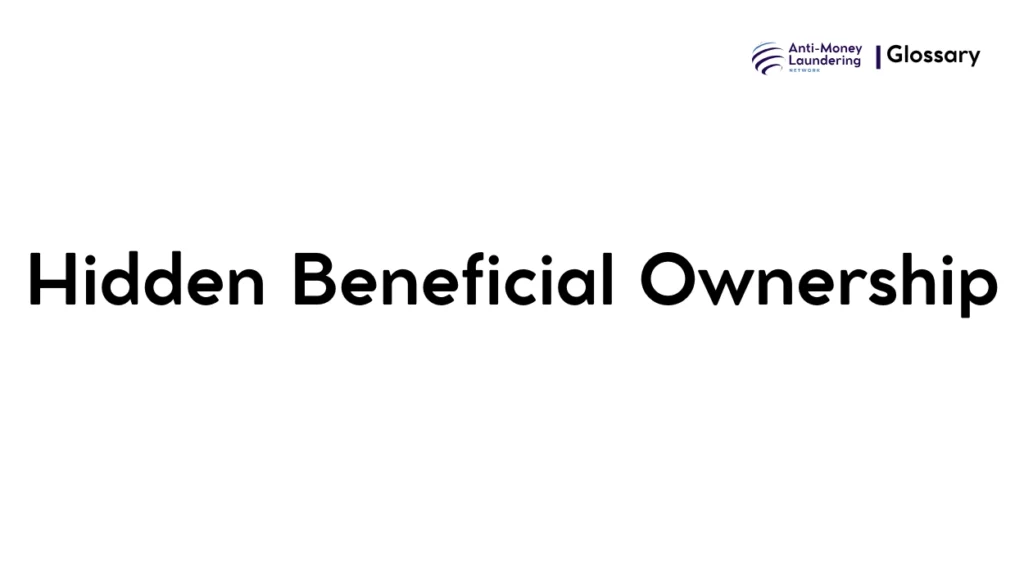Definition
Hidden beneficial ownership in anti-money laundering (AML) refers to the deliberate concealment or obscuring of the true individual(s) who ultimately own or control an asset, company, or legal entity. While legal ownership is publicly recorded, the beneficial owner is the person or group who truly benefits from or exercises control over the entity but whose identity is masked through complex ownership structures, nominees, trusts, or offshore entities. This concealment creates significant challenges for identifying and verifying the true controllers for AML compliance purposes.
Purpose and Regulatory Basis
The core purpose of identifying beneficial ownership is to prevent illicit activities such as money laundering, terrorist financing, tax evasion, and corruption. Criminals use hidden beneficial ownership to disguise illegal proceeds by obscuring control and ownership trails, making it difficult for authorities to trace funds back to the real perpetrators. To counter this, major international AML regulatory frameworks emphasize transparency and disclosure of beneficial ownership:
- The Financial Action Task Force (FATF) Recommendations, especially Recommendation 24, require regulated entities to identify and verify beneficial owners to disrupt financial crime.
- The USA PATRIOT Act mandates financial institutions to perform due diligence to determine beneficial owners of legal entities opening accounts.
- The European Union’s Anti-Money Laundering Directives (AMLD) include provisions to enhance transparency of beneficial ownership across member states.
These regulations compel financial institutions and businesses to implement stringent controls to detect and prevent hidden ownership that could facilitate financial crime.
When and How it Applies
Hidden beneficial ownership is especially relevant in scenarios involving legal entities with complex or layered structures. Real-world cases include:
- Corporations with multiple ownership tiers spanning different jurisdictions.
- Use of shell companies, front companies, or shelf companies to mask the identity of ultimate controllers.
- Trusts or legal arrangements where the beneficiaries or controllers are not disclosed publicly.
- Situations triggering enhanced due diligence, such as high-risk customers, politically exposed persons, or transactions crossing borders.
For instance, a multinational company may be owned by several holding companies abroad, ultimately controlled by an individual who avoids direct listing to evade detection. Financial institutions must unravel these layers during customer onboarding and ongoing monitoring to comply with AML rules.
Types or Variants of Hidden Beneficial Ownership
Complex Corporate Structures
Use of multiple layers of companies across jurisdictions to create opaque ownership chains.
Nominee Shareholders/Directors
Appointing intermediaries to act as official owners or controllers while true beneficial owners remain anonymous.
Trusts and Legal Arrangements
Utilizing trusts or similar structures where ownership rights and control are separated and not transparent.
Shell and Shelf Companies
Shell companies with no substantive operations and shelf companies held dormant for future use act as vehicles for concealment.
Front Companies
Legitimate-seeming firms that serve solely to disguise illicit activities and ownership.
Procedures and Implementation
Identification and Verification
Institutions must identify and verify the beneficial owners during client onboarding by:
- Requesting ownership and control information.
- Using reliable, independent sources to confirm identities.
- Applying enhanced due diligence for complex or high-risk ownership structures.
Ongoing Monitoring
Regular reviews and monitoring updates ownership information and flag changes or suspicious activity.
Use of Technology
Automated tools and databases help trace complex ownership networks, detect hidden owners, and maintain accurate records.
Collaboration with Authorities
Timely reporting of suspicious ownership structures enhances compliance and supports law enforcement.
Impact on Customers/Clients
From a customer perspective, disclosure of beneficial ownership:
- Imposes additional documentation and verification requirements.
- May raise privacy and confidentiality concerns.
- Introduces scrutiny into ownership arrangements, potentially delaying onboarding.
- However, it is essential for legitimate business to ensure transparency and regulatory adherence.
Duration, Review, and Resolution
- Beneficial ownership information should be verified at the time of onboarding and reviewed periodically—frequency depending on risk level.
- Any changes in ownership or control must trigger reassessment.
- Resolution of discrepancies or unclear ownership may require escalation or refusal of service until clarity is achieved.
Reporting and Compliance Duties
Financial institutions and regulated entities must:
- Maintain accurate records of beneficial ownership information.
- Report suspicious ownership or control patterns to relevant authorities.
- Ensure compliance with local and international AML regulations.
- Face penalties for failure to identify or disclose hidden beneficial owners, including fines and reputational damage.
Related AML Terms
- Ultimate Beneficial Owner (UBO): The individual(s) who ultimately own or control an entity.
- Legal Ownership vs. Beneficial Ownership: Legal owners are registered formally, beneficial owners exercise real control.
- Enhanced Due Diligence (EDD): Additional scrutiny for higher-risk beneficial owners.
- Shell Companies: Often used to facilitate hidden ownership.
Challenges and Best Practices
Challenges
- Complex, multi-jurisdictional ownership chains.
- Use of nominees and intermediaries.
- Incomplete or inaccurate information.
- Limited public access to ownership registers in some countries.
Best Practices
- Implement robust due diligence frameworks.
- Leverage technology for ownership tracing.
- Regularly update beneficial ownership data.
- Collaborate internationally for transparency and enforcement.
Recent Developments
- Increased global push for public beneficial ownership registers.
- Use of advanced analytics and AI to detect hidden ownership.
- Enhanced regulatory requirements in jurisdictions worldwide.
- Growing transparency mandates under updated AML directives and laws.
Hidden beneficial ownership poses a significant challenge in anti-money laundering efforts by concealing the true controllers of assets and companies. Identification and verification of beneficial owners are critical regulatory requirements designed to prevent misuse of the financial system for illicit purposes. Financial institutions must adopt comprehensive procedures, technology, and ongoing monitoring to detect hidden ownership effectively and ensure AML compliance. Transparency in beneficial ownership is crucial to protecting the integrity of the financial system globally.

